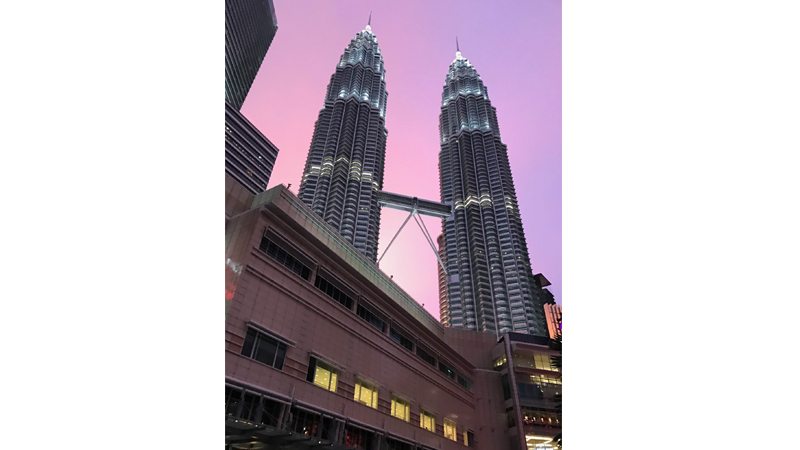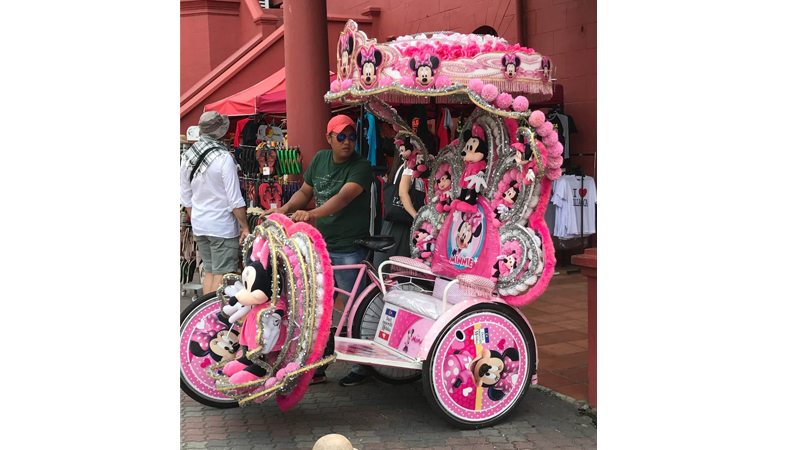 We were in a taxi heading from the modern part of Kuala Lumpur, where our hotel was located, to a traditional part of town. The goal was to savor street food. Suddenly, a thunderstorm descended on us. It came without warning. There were flashes of lightening and a downpour that left nothing dry.
We were in a taxi heading from the modern part of Kuala Lumpur, where our hotel was located, to a traditional part of town. The goal was to savor street food. Suddenly, a thunderstorm descended on us. It came without warning. There were flashes of lightening and a downpour that left nothing dry.
The rain totally covered the windshield of the taxi, putting to shame the wipers sweeping the glass at full speed. At some point, I felt a dampness descend on my trousers. The water must be seeping through the windows. But it was not visible. That had never happened before and was a bit frightening. My mind said it is nothing to be afraid of. The rubber sealant must have worn out in the persistent sweltering heat
of the tropics.
But before I could say anything to the driver, he said: “I don’t think I can take you to the bazaar with the street food. The storm is very intense. Let me drop you at the next mall. You can eat there and then decide whether you want to go back to your hotel or make another attempt to check out the street food. Do save some room for dessert.”
Our input was not solicited. He had made the decision for us. Sure enough, in a few minutes, we were coming out of the taxi and stepping onto the pavement of the shopping mall. But a few feet of pavement still had to be walked upon under the open sky. We made it to the inside of the mall but our clothes felt wet all over.
That was our introduction to the mercurial weather of Malaysia. Over the next few days, we would tour quite a few places in Kuala Lumpur, the capital of the country. There was so much to see.
We took the train one day to an older shopping mall which was known for its culture. It had an international collection of shops. A shop specialised in Kashmiri merchandise. We just had to check that one out, even though we knew we would not be buying anything. The salesman spoke Urdu and I enjoyed chatting with him about the conditions ‘back home’.
Then we checked out the very elaborate, multi-story Islamic Museum. It was amazing.
The rain totally covered the windshield of the taxi, putting to shame the wipers sweeping the glass at full speed. At some point, I felt a dampness descend on my trousers. The water must be seeping through the windows. But it was not visible. That had never happened before and was a bit frightening
On a Friday, I said the prayers in a mosque. The Arabic sermon was very similar to what I had heard around the globe. But what made this mosque different from the ones in the US was that it was very large and totally packed with worshipers.
Of course, the Petronas Twin Towers were a major attraction not to be missed. Tickets had to be booked in advance. We took the elevators to the top and took in the view of the sprawling metropolis. After we had seen the towers, we walked around to see the towers. They were lit up brilliantly by an interesting combination of artificial lighting and the sunlight.
We also checked out the modern shopping mall that was nearby. It had all the same stores that you would see in any major world or capital city.
Another day we walked over to the Bird Park, which was situated near our hotel. The collections were extensive, easy to tour, and a joy to photograph. In one spot, you could have your picture taken with the birds on your shoulder.
We visited the Lord Murugan statue of a Hindu deity on another day. At 140 feet, it is the second tallest statue of a Hindu deity in the world and clearly the tallest in Malaysia. But we did not have time to climb all those steps up to the Batu Caves at whose feet the statue stands.
The tour was educationally enriching. We discovered that Malaysia was a kingdom comprised of 13 states and the king was chosen by rotation between the states. The country was divided into Peninsular Malaysia and Eastern Malaysia, which lies in Borneo. Singapore was once a part of Malaysia.
The capital is located in Putrajaya, which in Sanskrit could mean either the ‘prince’ or the ‘son of victory’. The use of Sanskrit was another reminder of why Malaysia and the surrounding countries were once called Indo-China. In the central part of town, there is a beautiful pink mosque with intricate tile work, the Prime Minister’s residence, with its green big dome flanked by two much smaller domes, and the ministry buildings including that of the Energy Commission.
We also did a day trip to the old town of Malacca, which lies in a historic state of the same name. It was conquered by the Portuguese in 1511. Admiral Albuquerque came from Goa with a naval force. On finding the Muslims, he massacred them and spared the others. The Dutch wrested control of Malacca in 1641. Ultimately, control passed on to the British. They brought the English language to the country.
Buildings in deep pink hearken back to the Portuguese, Dutch and British colonial eras. One of them is Christ Church dating back to 1753. There was a while marble plaque commemorating the visit of the Governor General of India in 1850. And a white marble plaque commemorating the diamond jubilee of Queen Victoria, dated 1897.
To get a view of the city and surrounding areas, we went up a tower. From the top, we spotted an old warship, a relatively new warship, an old seaplane, and an old fort.
There were a whole bunch of souvenir shops for tourists along the city streets. Also available for hire was a cycle rickshaw, dressed up in pink with Minnie Mouse memorabilia for no apparent reason.
Traffic is heavy around Kuala Lumpur, as is in most Asian cities. But there is a super-efficient train that connects the airport to the downtown area. That is the fastest way to come to town.
 On our last day, we shifted to a hotel near the airport since we had to catch an early morning flight. One of us had a bad cough and I thought it was a good idea to see the airport doctor before embarking on the long flight in the morning. We were happy to see the clinic was open at midnight. The doctor was very friendly and he also had the medications. That made our long journey home go smoothly.
On our last day, we shifted to a hotel near the airport since we had to catch an early morning flight. One of us had a bad cough and I thought it was a good idea to see the airport doctor before embarking on the long flight in the morning. We were happy to see the clinic was open at midnight. The doctor was very friendly and he also had the medications. That made our long journey home go smoothly.
A couple of days later, we discovered that there had been a major international incident at the same airport. The half-brother of the North Korean had been poisoned by two women who accosted him. He was brought to the same clinic for treatment but unfortunately succumbed to the poison.
Malaysia has proved to be a remarkable country. It had both modern architecture and colonial architecture. There was remarkable ethnic and religious harmony among its three major races, Malay, Chinese and Tamil Indian. Just about everyone understood and spoke English. The food was incredible. And the natural beauty and the tropical climate made it an unforgettable destination.
The writer has traveled to 36 countries and can be reached at Ahmadfaruqui@gmail.com
Published in Daily Times, February 11th 2018.